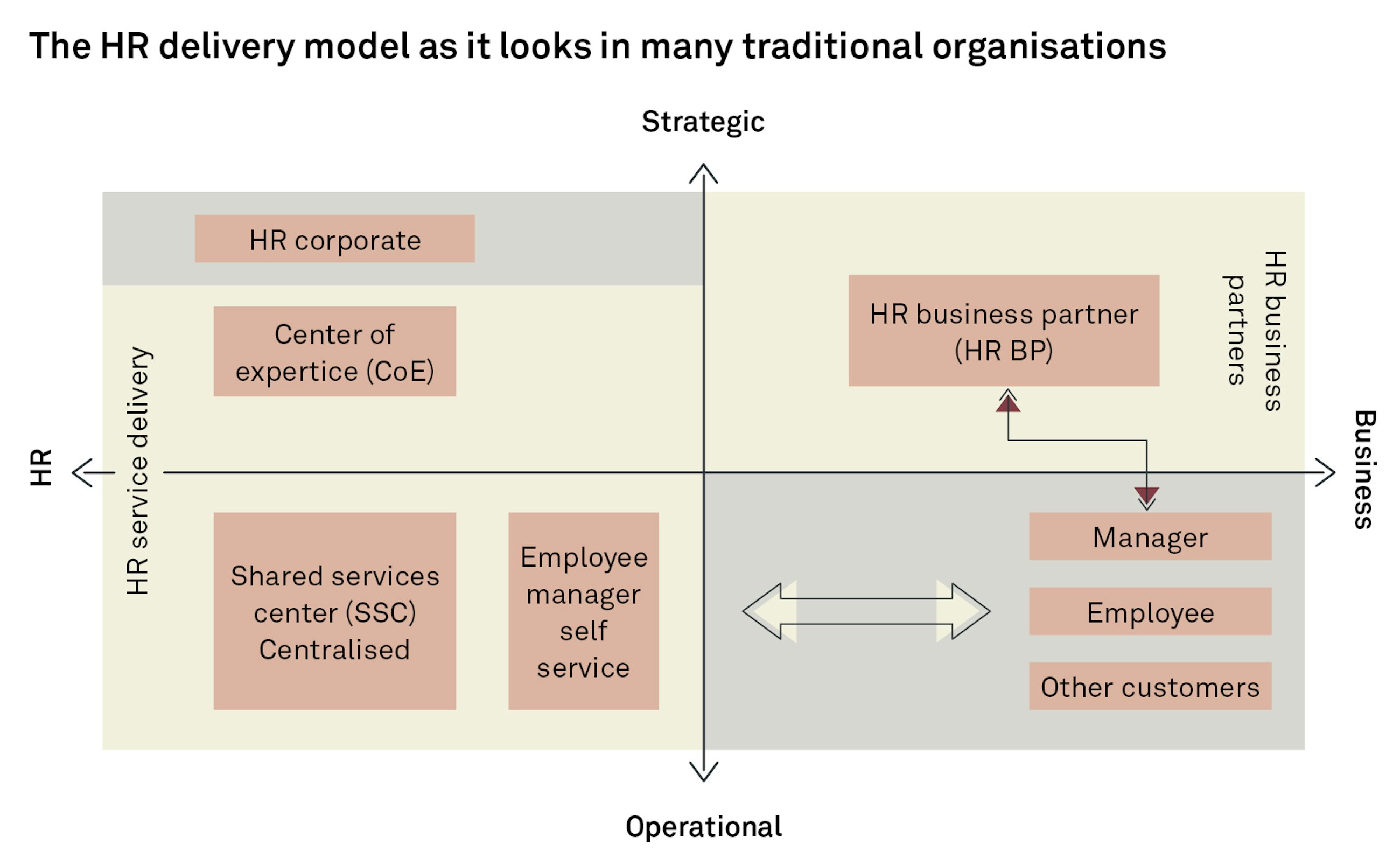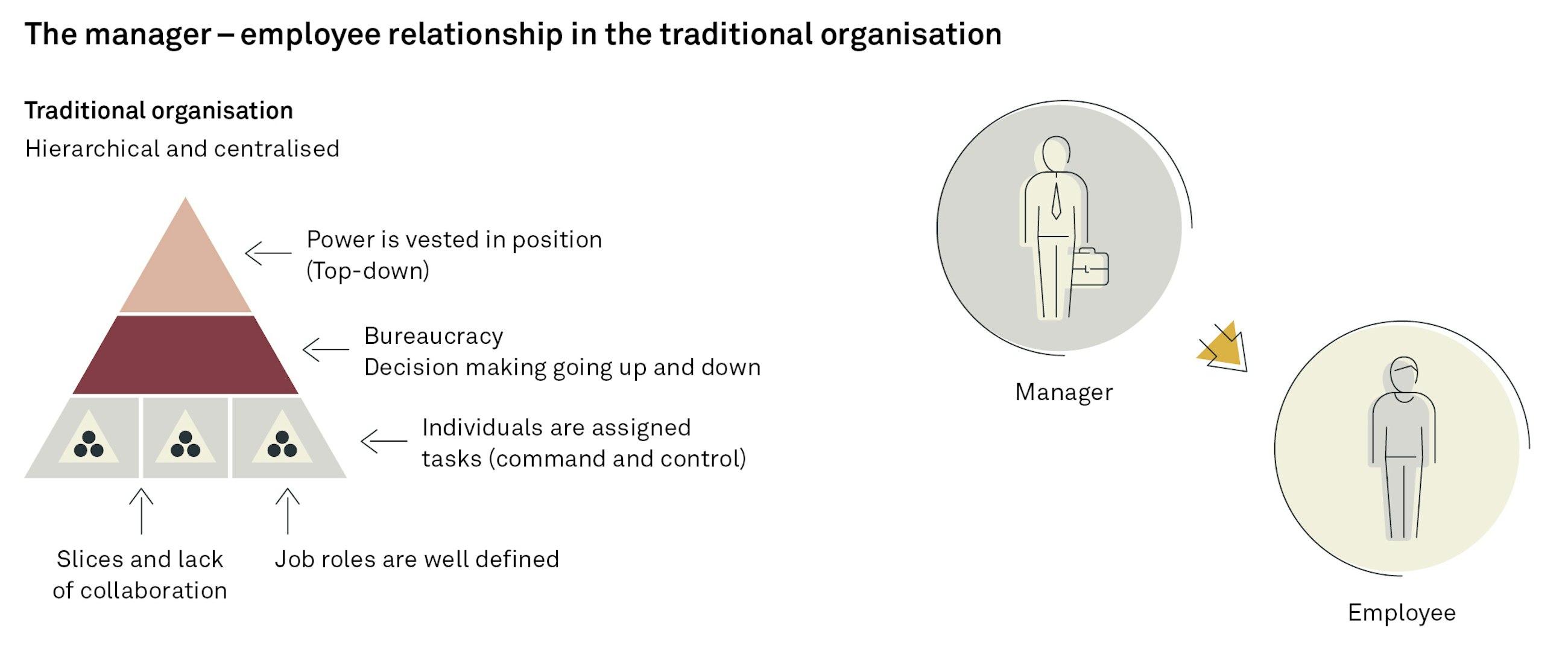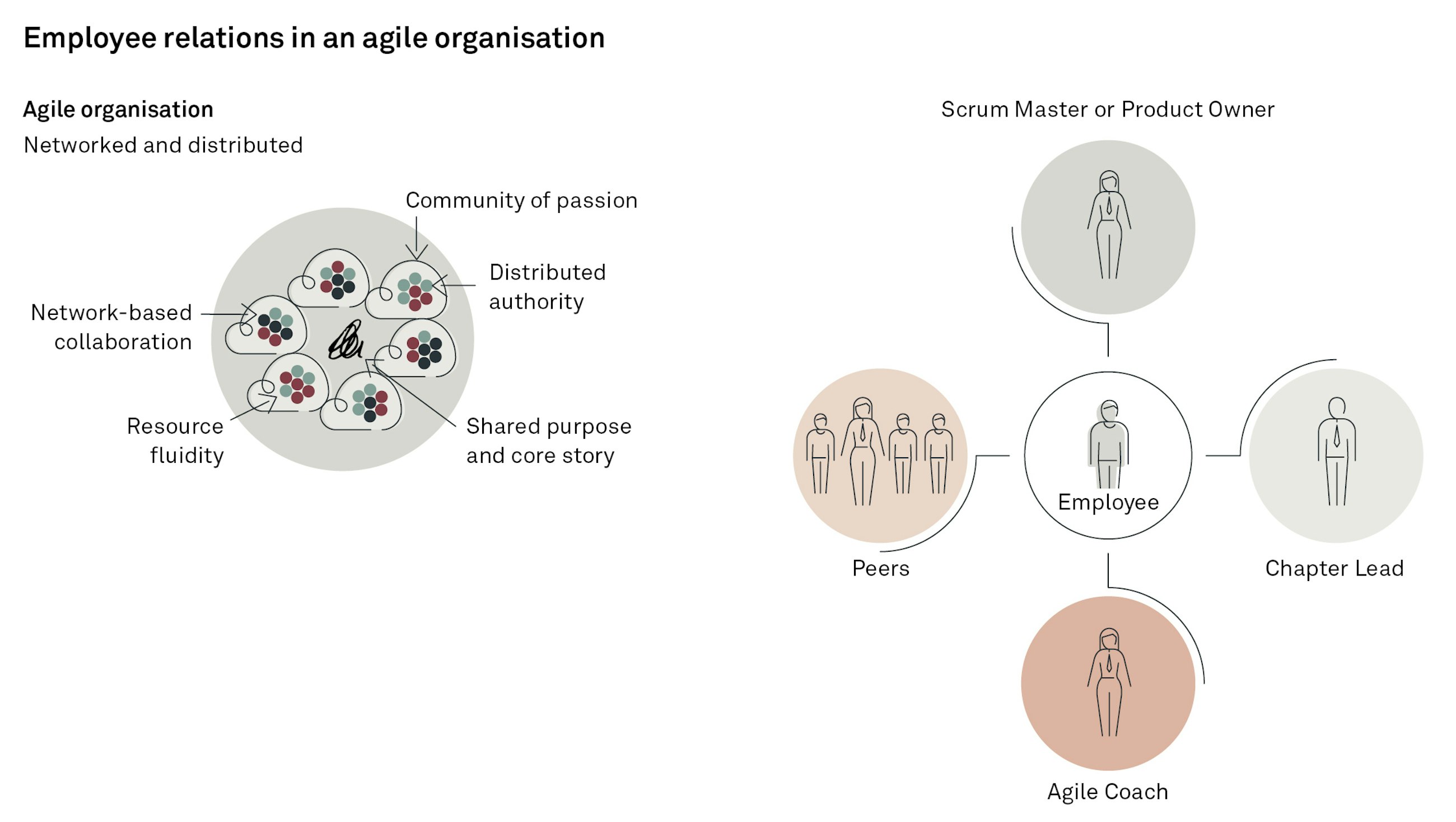How should HR react and adapt?
31 March 2022
Is your organisation implementing new ways of working? If so, what implications does this have for your HR department?
Society is constantly changing, and production processes are continuously optimised to make the road from idea to product launch as short as possible. For this very reason, the agile management style is gaining ground and spreading to areas that go far beyond digital development. It allows businesses to make quick decisions and transformations, matching a rapidly changing marketplace and giving them a competitive edge.
But what does the agile restructuring entail for HR when parts of the company suddenly switch to working with a high degree of professionalism in autonomous teams in flat management structures?
This article will address challenges for HR during an agile transformation and how these are solved. Among other things, we will look at how the rapid transition impacts HR and how it changes the traditional perception of HR.
Agile transformations in organisations
The agile leadership approach is popular, but often the demands on support functions such as HR and Finance are overlooked when the time comes to implement the changes. Because what exactly does it mean that an organisation becomes more agile, and what impact does this have on the way you structure your governance processes?
When we talk about adapting to the agile organisation structure, we can speak of a “hyper-awareness” where all departments must have a 360-degree orientation about internal and external factors in order to be able to follow up on what is happening in the marketplace. Whereas in the past, the annual wheel mapped out the course for your company, now we are talking about a new work approach that can change from one month to the next, depending on what is happening in the industry. Previously, you had rigid decision-making procedures in a visible leadership hierarchy, but now the decision-making process is in the hands of individual teams, and decisions are often reached in decision-making forums.
Adaptability is therefore the keyword for the agile organisation – across all departments. Choosing to only transform parts of the value chain in the company to agile is not an option. No, in order to establish a successful agile transformation, a new business-wide collaboration model must be supported to expose all opportunities and risks.
An agile transformation in the organisation means that the organisation is gradually transformed to accommodate and thrive in a more flexible, self-organised and changing environment. It is essential that the entire organisation – every manager and employee – understands and knows the definition and value of an agile transformation.
The same goes for HR. But it can be challenging to figure out how HR should adapt to and support the requirements for a new and successful agile organisation. The agile management style disrupts the traditional approach to HR. Naturally, this has consequences for the entire work procedure because it puts completely new demands on the internal cooperation in the company. But what are the implications? And does it even make sense for HR to facilitate annual appraisals and annual KPIs for team members whose team plan only extends three months into the future?
The importance of the traditional organisational structure
To better identify how HR should adapt its structure to the agile approach, it is essential to first look at the characteristics of a traditional organisation and HR department. We need to know the starting point when we talk about adapting and transforming HR’s practices.
Most organisations are built around a solid manager-employee relationship where the manager is fully responsible for his or her team’s performance. The manager is in charge of personnel, can hire and dismiss employees and ensures adequate professional competencies in the team. The manager is financially responsible and signs off on departmental expenditure. The manager is responsible for the professional standard of work and is thus the top guarantor of the quality of the team’s performance. In short, the manager is responsible for leading and distributing the work in all its aspects. In HR terms, the team leader is responsible for recruitment, approval, development and performance.
HR’s workflows and practices are similarly built around the manager-employee relationship in the traditional organisational structure. This is evident in Dave Ulrich’s classic HR model (from 1995) in which “strategic partners”, among other things, support management with strategic and organisational issues while “administrative experts” assist the individual employee with administrative tasks such as leave or work permits.
In this way, the entire HR organisation and processes are often constructed around the managerial hierarchy. When the leadership hierarchy is disrupted during an agile transformation, it literally pulls the rug from under the HR function, and HR can effectively hinder the agile transformation if the department refuses or is unable to adapt.
The agile disruption and new talent definitions
When a company undergoes an agile transformation, the individual employee will typically no longer be assigned to just one manager. Instead, employees work in cross-functional and more or less self-managed teams. The classic employee-manager relationship is no longer so rigid and allows for new roles to come in and has a significant impact on the managerial functions in the teams.
Thus, the employee can have many roles, each covering some of the traditional managerial relationships.
Below is an example of agile roles adapted from the “Spotify model”:
- The Chapter Lead is responsible for the team’s professional development and setting the bar for professionalism. Talent development, onboarding and the general well-being of the employees are part of the role. The Chapter Lead will hold the overall responsibility for the employees in a given professional area.
- The Product Owner is the customers’ representative in the team and ensures that the customers’ needs are met, e.g. by prioritising the team’s deliverables.
- The Scrum Master coordinates the team’s deliverables and facilitates allocation of employees to each task. The Scrum Master is an expert in agile processes and ensures that the goal is successfully achieved.
- Finally, the Agile Coach assists the Scrum Master and facilitates the processes by aligning the team with the agile practices, values and mindset.
In addition to the above-mentioned agile roles, employees also collaborate with peers and teammates on the products on a day-to-day basis.
The talent definition also usually broadens within companies working agile. Previously, many companies focused on developing tomorrow’s leaders – typically generalists with solid business understanding and highly developed skills for leading and distributing. Some knowledge-intensive companies had a parallel specialist track to nurture the specialists of the future.
In an agile company, future success mainly depends on the power of innovation. Here, talent is recognised as the potential to become an innovator of the future – usually with a high degree of specialist knowledge combined with a profound understanding of consumers and their needs. Traditional personnel development, career and remuneration models based on a hierarchical organisation are thus entirely inadequate.
How should HR respond to the agile transformation?
New work structures call for new processes and a new HR organisation. We have spoken to several agile teams, managers and HR departments in agile organisations, and they all point to the same questions that they need to find new answers to:
- “Who is now in charge of hiring and firing people?”
- “Who heads up development and personal KPIs, and are they even relevant now?”
- “How do we meet employees’ personal development and career progression requirements in a flat organisation?”
- “How should HR regroup to support all these new needs, roles and relationships in our organisation?”
We have identified three areas where HR should respond to the agile transformation to achieve a structure that caters for all departments in the company:
1. The workflows in your organisation
In the agile organisation, there is no longer one leader with the power to make all decisions in all areas, and so you must define new decision models and decision-making forums encompassing all relevant roles and stakeholders in the organisation. It is essential to ensure that the right people make decisions on talent.
As far as HR goes, we have identified several ways of achieving this goal:
- Decisions on talents still rest with one person, but that person may vary depending on the area, e.g. the Chapter Lead may be overall responsible for personnel development while task management and daily management are in the hands of someone in the agile team. This pattern is usually evident in organisations that have taken the first tentative steps on their agile journey but are still very much bound by the traditional leadership relationship.
- An increased tendency is also to have talent decision-making forums, where decisions about hiring, pay and careers are handled by teams of colleagues who have a combined 360-degree perspective on an employee. In this scenario, employees are calibrated in relation to each other. You get a transparent talent development process and a fair assessment, which is beneficial to all employees. This type of approach is evident in organisations that are far along on their agile journey. For example, Google and Spotify are organisations that practise this very transparent approach and offer optimal conditions for increasing the talent pool in their teams.
2. The organisation of HR
You should also look at the way your HR department is structured. It no longer makes sense for HR to focus on supporting management and individual employees’ needs, respectively. On the contrary, HR can benefit from shifting its focus to the teams of employees and supporting the different areas of expertise instead of the departments, thus gaining an in-depth knowledge of the teams. Going forward, recruitment, salary and career counselling may be carried out by a professionally oriented HR employee who knows the different talent markets, the competition out there and the dominant motivators in the different talent segments. Such a professionally oriented HR function supports the increased focus on professionalism and innovation and allows the company to retain its highly skilled employees long term.
You need to develop an HR organisation that can continue to provide strategic sparring at the top level, provide managerial and personnel nurturing of the various teams and tribes and continue to help the individual employee with their specific employment needs.
Agile Coaches are involved in this process in some HR departments. Their role is to facilitate agile workflows in the teams, including sparring on personnel management, motivation, high-performing teams etc. It is a natural extension of HR’s traditional domain in leadership development.
3. The HR work method
You also need to adjust your work method. It is not conducive to an agile work structure to have a “centre of expertise” that develops your organisation’s policies and processes based on an analysis-design-build-implement-model, allowing only for a small and very late involvement of the rest of the HR organisation and other key stakeholders. Rather, HR should implement more agile workflows with high user involvement from the start, continuously tweaking and adjusting as the organisation evolves and changes.
It varies greatly how each HR department approaches this issue. In some companies, HR continues to develop and adjust staff issues in the department itself – although in an agile flow with increased business involvement.
Other companies take a more drastic approach and set up HR partners in a kind of Scrum Master role where they facilitate a team working on a particular personnel-related topic such as employee engagement. Such a team then goes on to involve experts in e.g. motivation and engagement, experts in incentive programmes as well as customers or clients, IT experts and anyone else who may be relevant to include in the cross-departmental team on employee engagement. Thus, HR can operate in its field and come up with solutions tailored to suit the challenges in business conditions and still rely on its employees’ unique knowledge and expertise in psychology.
The future HR organisation
Going forward, and regardless of which model you choose, your HR department’s solutions should not be designed to fit long-term projects but should instead be introduced through development processes that develop MVPs (minimum viable products) that can be tested in smaller groups. When solutions are finally launched, you can still make several adjustments, improvements and new releases along the way. This is the only way your HR department can support your business and remain up to date and abreast of a constantly evolving marketplace.
These are all just examples of how you can organise the management structure and workflows in HR to be more adapted to the agile process. If management asks you to take a helicopter view and a strategic perspective, then one thing is for certain: the old ways are not agile and no longer represent a solution. Rather, HR should embrace a transparent organisation and way of working that is consistent with what the workflow required from the employees, allowing the department to support the agile management structure to the best of its ability.
Agile transformation
– Establishing a powerful, soulful and meaningful organisation for your employees
Read more



